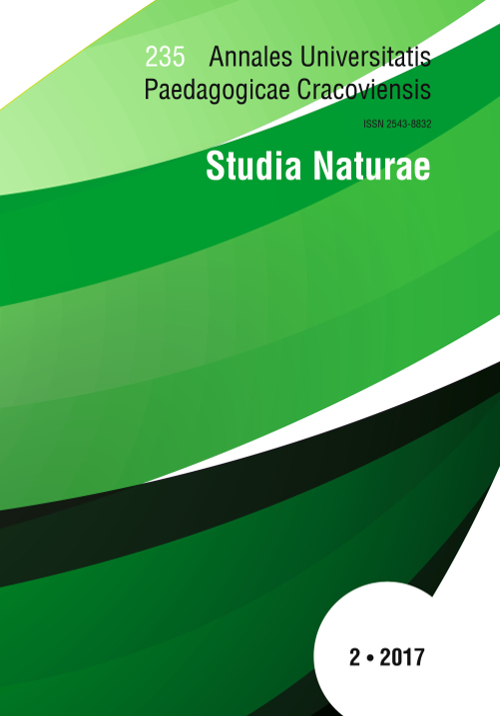Composition of phytoplankton in the Puck Bay and the open Baltic Sea
DOI:
https://doi.org/10.24917/25438832.2.2Keywords:
phytoplankton, Puck Bay, Southern Baltic Sea, bloomsAbstract
The Puck Bay is an area characterised by specific hydrodynamic conditions that determine the distribution and composition of phytoplankton. The aim of this study was to investigate the differences in the phytoplankton composition and the content of photosynthetic pigments between the Puck Bay and open Baltic Sea. The material was collected from four stands which were localised in the inner and outer part of Hel Peninsula. In this study, it has been demonstrated that the composition of individual species of phytoplankton differed between stands in the inner and outer part of the Puck Bay. This investigation has also shown that the number of phytoplankton taxa was similar in three stands and it was much lower on the last stand (Stand 4). The differences in the concentration of photosynthetic pigments between all stands have also been observed.
Downloads
Metrics
References
Fleming, V., Kaitala, S. (2006). Phytoplankton spring bloom intensity index for the Baltic Sea estimated for the years 1992 to 2004. Hydrobiologia, 554(1), 57–65. https://doi.org/10.1007/s10750-005-1006-7
Guiry, M.D., Guiry, G.M. (2017). AlgaeBase. World-wide electronic publication. Aphanizomenon flosaquae Ralfs ex Bornet & Flahault, Nodularia spumigena Mertens ex Bornet & Flahault, Chlorella vulgaris Beyerinck [Beijerinck]. National University of Ireland, Galway. http://www.algaebase.org
Ikawa, M., Haney, J.F., Sasner, J.J. (1994). Inhibition of Chlorella growth by the lipids of cyanobacterium Microcystis aeruginosa. Hydrobiologia, 331, 167–170. https://doi.org/10.1007/BF00025418
Jeffrey, S., Vesk, M. (1997). Introduction to marine phytoplankton and their pigment signatures. In: S. Jeffrey, R. Mantoura, S. Wright (eds.), Phytoplankton pigments in oceanography: Guidelines to modern methods. Paris, France: UNESCO Publ., pp. 37–84.
Jeffrey, S.T., Humphrey, G.F. (1975). New spectrophotometric equations for determining chlorophylls a, b, c1 and c2 in higher plants, algae and natural phytoplankton. Biochemie und Physiologie der Pflanzen, 167(2), 191–194. https://doi.org/10.1016/S0015-3796(17)30778-3
Kearns, K.D., Hunter, M.D. (2000). Green algal extracellular products regulate antialgal toxin production in a cyanobacterium. Environmental Microbiology, 2, 291–297. https://doi.org/10.1046/j.1462-2920.2000.00104.x
Keating, K.I. (1978). Blue-green algal inhibition of diatom growth: transition from mesotrophic to eutrophic community structure. Science, 199, 971–973. https://doi.org/10.1126/science.199.4332.971
Klekot, L. (1980). Zatoka Pucka osobliwością hydrologiczną Bałtyku. Oceanologia, 12, 109–123. [In Polish]
Kuczyńska, P., Jemioła-Rzemińska, M., Strzałka, K. (2015). Photosynthetic pigments in diatoms. Marine Drugs, 13(9), 5847–5881. https://doi.org/10.3390/md13095847
Mazur-Marzec, H., Sutryk, K., Kobos, J., Hebel, A., Hohlfeld, N., Błaszczyk, A., Toruńska, A., Kaczkowska, M.J., Łysiak-Pastuszak, E., Kraśniewski, W., Jasser, I. (2012). Occurrence of cyanobacteria and cyanotoxin in the Southern Baltic Proper. Filamentous cyanobacteria versus single-celled picocyanobacteria. Hydrobiologia, 701, 235–252. https://doi.org/10.1007/s10750-012-1278-7
Olenina, I., Hajdu, S., Edler, L., Andersson, A., Wasmund, N., Busch, S., Göbel, J., Gromisz, S., Huseby, S., Huttunen, M., Jaanus, A., Kokkonen, P., Ledaine, I. Niemkiewicz, E. (2006). Biovolumes and size-classes of phytoplankton in the Baltic Sea HELCOM. Baltic Sea Environmental Programme, 106.
Olli, K., Klais, R., Tamminen, T., Ptacnik, R., Andersen, T. (2011). Long term changes in the Baltic Sea phytoplankton community. Boreal Environmental Resources, 16, 3–14.
Pliński, M. (1980). Glony zatoki Gdańskiej: klucz do oznaczania gatunkow. Gdańsk: Wydawnictwo Uniwersytetu Gdańskiego. [In Polish]
Pliński, M., Picińska, J. (1985). The dynamics of seasonal change of the phytoplankton biomass in the Gulf of Gdańsk, Oceanologia, 23, 77–83.
Suikkanen, S., Laamanen, M., Huttunen, M. (2007). Long-term changes in summer phytoplankton communities of the open northern Baltic Sea. Estuarine, Coastal and Shelf Science, 71, 580–592. https://doi.org/10.1016/j.ecss.2006.09.004
Wasmund, N., Nausch, G., Matthäus, W. (1998). Phytoplankton spring blooms in the southern Baltic Sea-spatio-temporal development and long-term trends. Journal of Plankton Research, 20, 1099–1117. https://doi.org/10.1093/plankt/20.6.1099
Żmijewska, M.I., Niemkiewicz, E., Bielecka, L. (2000). Abundance and species composition of plankton in the Gulf of Gdansk near the planned underwater outfall of the Gdansk-Wschod (Gdansk-East) sewage treatment plant. Oceanologia, 42, 335–357.

